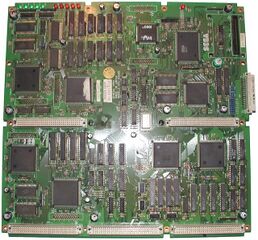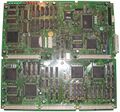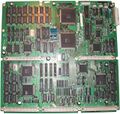Difference between revisions of "Sega Model 2"
From Sega Retro
(→Memory) |
|||
| Line 73: | Line 73: | ||
* [[wikipedia:Digital geometry|Geometric]] performance: | * [[wikipedia:Digital geometry|Geometric]] performance: | ||
** Model 2: 300,000 textured [[wikipedia:Polygon mesh|quad polygons]]/sec to over 500,000 textured [[wikipedia:Triangle mesh|triangle polygons]]/sec, 900,000 [[wikia:w:c:gaming:Vector graphics|vectors]]/sec | ** Model 2: 300,000 textured [[wikipedia:Polygon mesh|quad polygons]]/sec to over 500,000 textured [[wikipedia:Triangle mesh|triangle polygons]]/sec, 900,000 [[wikia:w:c:gaming:Vector graphics|vectors]]/sec | ||
| − | ** Model 2C-CRX: 490,000 textured [http://www.giantbomb.com/polygonal-3d/3015-1430/ polygons]/sec (with clipping, lighting and [[Gouraud shading]]) | + | ** Model 2C-CRX: 490,000 textured [http://www.giantbomb.com/polygonal-3d/3015-1430/ polygons]/sec (with clipping, lighting and [[Gouraud shading]]), 900,000 textured triangle polygons/sec (with Gouraud shading), 1.7 million triangle polygons/sec (with [[wikipedia:Flat shading|flat shading]]){{ref|http://www.hotchips.org/wp-content/uploads/hc_archives/hc07/3_Tue/HC7.S5/HC7.5.1.pdf}} |
* Rendering [[wikipedia:Fillrate|fillrate]]: | * Rendering [[wikipedia:Fillrate|fillrate]]: | ||
** [[Pixel]] fillrate: 1.2 million pixels/sec (Model 2) to 120 million pixels/sec (2 million pixels/frame) (Model 2B-CRX/2C-CRX) | ** [[Pixel]] fillrate: 1.2 million pixels/sec (Model 2) to 120 million pixels/sec (2 million pixels/frame) (Model 2B-CRX/2C-CRX) | ||
Revision as of 07:14, 11 October 2015

| |||||
| Sega Model 2 | |||||
|---|---|---|---|---|---|
| Manufacturer: Sega | |||||
|
The Sega Model 2 is an arcade system board originally debuted by Sega in 1993 as a successor to the Sega Model 1 board. It is an extension of the Model 1 hardware, most notably introducing the concept of texture-mapped polygons, allowing for more realistic 3D graphics (for its time). The Model 2 board was an important milestone for the arcade industry, and helped launch several key arcade franchises of the 90s, including Daytona USA, Virtua Cop, Sega Rally Championship, Dead or Alive, Virtua Striker, Cyber Troopers Virtual-On and The House of the Dead.
The Model 2 was engineered with help from GE Aerospace (acquired by Martin Marietta in 1993, now part of Lockheed Martin), who designed the texture-mapping technology incorporated by the Model 2. The Model 2's development was led by famed game designer Yu Suzuki. The Model 2 arcade board debuted along with Daytona USA, a game which was finished, copyrighted and debuted at the JAMMA arcade show in 1993.[1]
There four versions of the system: the original Model 2 and the Model 2A-CRX, Model 2B-CRX and Model 2C-CRX variants. Model 2 and 2A-CRX used a custom DSP with internal code for the geometrizer while 2B-CRX and 2C-CRX used well documented DSPs and uploaded the geometrizer code at startup to the DSP. The Model 2 was succeeded by the Sega Model 3 in 1996.
Contents
History
It was a further advancement of the earlier Model 1 system. The most noticeable improvement was texture mapping, which enabled polygons to be painted with bitmap images, as opposed to the limited monotone flat shading that Model 1 supported. The Model 2 also introduced the use of texture filtering and texture anti-aliasing, [1] as well as trilinear filtering.[2] It was the most powerful game system in its time, equivalent to the power of a PC graphics card in 1998, five years after the Model 2's release.[2]
Designed by Sega AM2's Yu Suzuki, he stated that the Model 2's texture mapping chip originated "from military equipment from Lockheed Martin, which was formerly General Electric Aerial & Space's textural mapping technology. It cost $2 million dollars to use the chip. It was part of flight-simulation equipment that cost $32 million. I asked how much it would cost to buy just the chip and they came back with $2 million. And I had to take that chip and convert it for video game use, and make the technology available for the consumer at 5,000 yen ($50)" ($84 in 2014) per machine. He said "it was tough but we were able to make it for 5,000 yen. Nobody at Sega believed me when I said I wanted to purchase this technology for our games."[3] Suzuki stated that, in "the end," it "was a hit and the industry gained mass-produced texture-mapping as a result." For Virtua Fighter 2, he also utilized motion capture technology, introducing it to the game industry.[4]
There were also issues working on the new CPU,[3] the Intel i960-KB, which had just released in 1993.[5] Suzuki stated that when working "on a brand new CPU, the debugger doesn't exist yet. The latest hardware doesn't work because it's full of bugs. And even if a debugger exists, the debugger itself is full of bugs. So, I had to debug the debugger. And of course with new hardware there's no library or system, so I had to create all of that, as well. It was a brutal cycle."[3]
In a late 1998 interview, Read3D's Jon Lenyo, a former employee of GE Aerospace (later Lockheed Martin), stated that Sega's development for the Model 2 can be traced back as early as November 1990, when he and other GE Aerospace employees visited Sega and demonstrated the trilinear texture filtering and shading capabilities of their technology. As Sega was already working on the Sega Model 1 internally, they eventually incorporated GE Aerospace's technology into the Model 2.[2]
Despite its high price tag of around $15,000[2] (equivalent to $24489 in 2014), the Model 2 platform was very successful. It featured some of the highest grossing arcade games of all time: Daytona USA, [2] Virtua Fighter 2, Cyber Troopers Virtual-On, The House of the Dead, and Dead or Alive, to name a few. Sega sold 65,000 units of the Model 2 annually,[2] and eventually sold over 130,000 units by 1996, amounting to over $1.95 billion revenue from hardware cabinet sales (130,000 units[6][7] at $15,000 each[2][8]), equivalent to over $3.18 billion in 2014, making it one of the best-selling arcade systems of all time.
Technical Specifications
Main CPU
- Main CPU (central processing unit) processor: Intel i960-KB @ 25 MHz
- Fixed-point arithmetic: 32-bit RISC instructions @ 25 MIPS (million instructions per second)
- Floating-point unit: 32-bit, 64-bit and 80-bit operations @ 13.6 MFLOPS (Mega-FLOPS, or million floating-point operations per second) (Whetstone)
Audio
- Audio hardware:
- Sound CPU: Motorola 68000 @ 10 MHz (Model 2), or Motorola 68000 @ 12 MHz (Model 2A/2B/2C-CRX)
- Sound chip: 2× Sega 315-5560 Custom MultiPCM (Model 2), or Yamaha SCSP (Model 2A/2B/2C-CRX)
- Sound timer: Yamaha YM3834 @ 8 MHz (Model 2 only)
- PCM channels: 56
- PCM sample ROM: 16 Mbits (Model 2), or 68 Mbits (Model 2A/2B/2C-CRX)
- PCM quality: 16-bit depth, 44.1 kHz sampling rate (CD quality)
- SCSP features: 128-step DSP, 32 FM synthesis channels, 32 MIDI channels, 32 LFO channels
Graphics
- Geometry Engine DSP coprocessors: 6× Fujitsu TGP MB86234 (Model 2/2A-CRX), or 2× Analog Devices ADSP-21062 SHARC (Model 2B-CRX), or 2× Fujitsu TGPx4 MB86235 (Model 2C-CRX)
- Coprocessor abilities: Floating decimal point operation function, axis rotation operation function, 3D matrix operation function
- Floating-point unit:
- Model 2/2A-CRX: 32-bit operations @ 16 MFLOPS ×6 (96 MFLOPS)
- Model 2B/2C-CRX: 32-bit & 40-bit operations @ 120 MFLOPS ×2 (240 MFLOPS)
- Fixed-point arithmetic: 32-bit & 48-bit instructions @ 80 MIPS (Model 2B-CRX)
- Hardware Renderer: Sega-Lockheed-Martin Custom rasterization & texture mapping hardware (Model 2), or 2× Fujitsu MB86271 AGP (Model 2C-CRX)
- Fixed-point arithmetic: 32-bit & 64-bit instructions @ 240 MIPS (Model 2C-CRX)
- Z-Sort & Clip Hardware (2× Fujitsu MB86272 Z-sorter in Model 2C-CRX)
- Sega System 24 tilemap engine
- Graphical capabilities
- Monitor display resolution: 496×384 pixels, 24 Hz horizontal sync, 60 Hz refresh rate, progressive scan (non-interlaced)
- Color depth: 16,777,216 (24-bit true color)
- Graphical features: Flat shading, texture mapping, perspective correction, Texture filtering, texture anti-aliasing, microtexture, diffuse reflection, specular reflection, wikipedia:Alpha blending, transparency, rasterization, mipmapping, level of detail, Z-sorting, T&L (transform, clipping, and lighting), trilinear filtering
- Texture map resolution: Up to 1024×2048 pixels
- Microtexture size: Up to 128×128 pixels
- Model 2C-CRX: Gouraud shading, hidden surface, Z-buffering, point sampling, bilinear filtering
- Frame rate: 60 frames/sec
- Geometric performance:
- Model 2: 300,000 textured quad polygons/sec to over 500,000 textured triangle polygons/sec, 900,000 vectors/sec
- Model 2C-CRX: 490,000 textured polygons/sec (with clipping, lighting and Gouraud shading), 900,000 textured triangle polygons/sec (with Gouraud shading), 1.7 million triangle polygons/sec (with flat shading)[9]
- Rendering fillrate:
Memory
- Model 2/2A-CRX
- Total RAM (random access memory) memory: 9776 KB
- Main RAM: 1152 KB (9 Mbits) (1024 KB work, 64 KB network, 64 KB serial)
- Video memory: 5984 KB
- Framebuffer VRAM: 1024 KB
- Coprocessor buffer SRAM/SDRAM: 64 KB
- Texture memory: 4096 KB SRAM/SDRAM
- Luma: 128 KB
- Other: 672 KB (32 KB geometry, 576 KB tiles, 64 KB colors)
- Audio memory: 576 KB
- Backup SRAM/NVRAM: 16 KB
- Extra RAM: 2048 KB
- Model 2B/2C-CRX
- Total RAM (random access memory) memory: 18,388 KB
- Main RAM: 1152 KB (9 Mbits) (1024 KB work, 64 KB network, 64 KB serial)
- Video memory: 14,596 KB
- Audio memory: 576 KB
- Backup SRAM/NVRAM: 16 KB
- Extra RAM: 2048 KB
List of Games
Model 2
- Daytona USA (1993)
- Daytona USA Deluxe '93 (1993)
- Desert Tank (1994)
- Virtua Cop (1994)
Model 2A-CRX
- Virtua Fighter 2 (1994)
- Manx TT Superbike (1995)
- Sega Rally Championship (1995)
- Sega Rally Pro Drivin' (1995?)
- Sky Target (1995)
- Virtua Cop 2 (1995)
- Dead or Alive (1996)
- Dynamite Baseball (1996)
- Dynamite Cop (1996)
- Pilot Kids (1999)
- Virtua Fighter 2.1 (1996)
- Motor Raid (1997)
- Zero Gunner (1997)
Model 2B-CRX
- Fighting Vipers (1995)
- Gunblade NY (1995)
- Indy 500 (1995)
- Rail Chase 2 (1995)
- Virtua Striker (1995)
- Dead or Alive (1996)
- Dynamite Baseball (1996)
- Dynamite Cop (1996)
- Last Bronx (1996)
- Pilot Kids (1999)
- Sonic the Fighters (1996)
- Super GT 24H (1996)
- Cyber Troopers Virtual-On (1996)
- Dynamite Baseball 97 (1997)
- Zero Gunner (1997)
Model 2C-CRX
- Dynamite Cop (1996)
- Over Rev (1997)
- Power Sled (1996)
- Sega Ski Super G (1996)
- Sega Touring Car Championship (1996)
- Sega Water Ski (1996)
- Wave Runner (1996)
- The House of the Dead (1997)
- Top Skater (1997)
- Behind Enemy Lines (1998)
Other
- Ultimate Domain (unreleased) - Developed by Atlus. Previewed in Mean Machines Sega #51.
Gallery
A typical ROM (Virtua Cop)
Model 2A ROM (Dead or Alive)
| Sega arcade boards |
|---|
| Originating in arcades |
|
77
78
79
80
81
82
83
84
85
86
87
88
89
90
91
92
93
94
95
96
97
98
99
|
| Console-based hardware |
|
84
85
86
87
88
89
90
91
92
93
94
95
96
97
98
99
00
01
02
03
04
05
06
07
08
09
10
11
12
13
14
|
| PC-based hardware |
|
05
06
07
08
09
10
11
12
13
14
15
16
17
18
19
20
21
22
23
|








